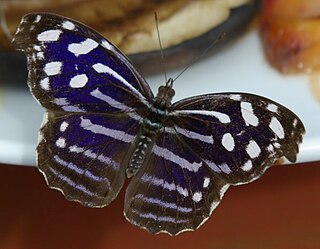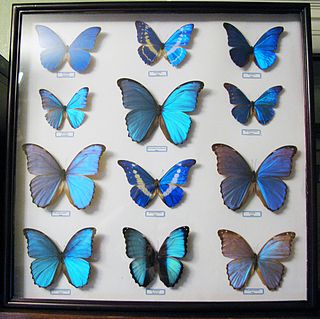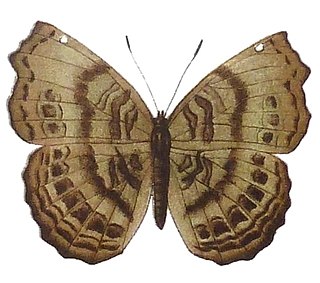
Danainae is a subfamily of the family Nymphalidae, the brush-footed butterflies. It includes the Daniadae, or milkweed butterflies, who lay their eggs on various milkweeds on which their larvae (caterpillars) feed, as well as the clearwing butterflies (Ithomiini), and the tellervini.

The Nymphalidae are the largest family of butterflies, with more than 6,000 species distributed throughout most of the world. Belonging to the superfamily Papilionoidea, they are usually medium-sized to large butterflies. Most species have a reduced pair of forelegs and many hold their colourful wings flat when resting. They are also called brush-footed butterflies or four-footed butterflies, because they are known to stand on only four legs while the other two are curled up; in some species, these forelegs have a brush-like set of hairs, which gives this family its other common name. Many species are brightly coloured and include popular species such as the emperors, monarch butterfly, admirals, tortoiseshells, and fritillaries. However, the under wings are, in contrast, often dull and in some species look remarkably like dead leaves, or are much paler, producing a cryptic effect that helps the butterflies blend into their surroundings.

The superfamily Papilionoidea contains all the butterflies except for the moth-like Hedyloidea.

The Heliconiinae, commonly called heliconians or longwings, are a subfamily of the brush-footed butterflies. They can be divided into 45–50 genera and were sometimes treated as a separate family Heliconiidae within the Papilionoidea. The colouration is predominantly reddish and black, and though of varying wing shape, the forewings are always elongated tipwards, hence the common name.

The Satyrinae, the satyrines or satyrids, commonly known as the browns, are a subfamily of the Nymphalidae. They were formerly considered a distinct family, Satyridae. This group contains nearly half of the known diversity of brush-footed butterflies. The true number of the Satyrinae species is estimated to exceed 2,400.

Ariadne merione, the common castor, is an orange butterfly with brown lines whose larvae feed almost exclusively on castor. It is similar in appearance to Ariadne ariadne, the angled castor.

Biblidinae is a subfamily of nymphalid butterflies that includes the tropical brushfoots. This subfamily was sometimes merged within the Limenitidinae, but they are now recognized as quite distinct lineages. In older literature, this subfamily is sometimes called Eurytelinae.

The Morphinae are a subfamily of Nymphalidae butterflies that includes the morphos, the owl butterflies (Caligo), and related lineages. It is either considered a sister group of the Satyrinae, or disassembled and included therein.
Butterfly evolution is the origin and diversification of butterflies through geologic time and over a large portion of the Earth's surface. The earliest known butterfly fossils are from the mid Eocene epoch, between 40-50 million years ago. Their development is closely linked to the evolution of flowering plants, since both adult butterflies and caterpillars feed on flowering plants. Of the 220,000 species of Lepidoptera, about 45,000 species are butterflies, which probably evolved from moths. Butterflies are found throughout the world, except in Antarctica, and are especially numerous in the tropics; they fall into eight different families.

The Elymniini is one of the tribes of the subfamily Satyrinae. If the subfamily Satyrinae elevate to family status, this tribe shall be treated as subfamily Elymniinae. Elymniini was formerly a large group, but recently, it is considered to be include only one genus, Elymnias, according to molecular phylogenetic analyses.

The butterfly subtribe Euptychiina is a diverse group within the tribe Satyrini, occurring throughout Central and South America, in addition to a few species known from North America. Euptychiina is a predominantly lowland group, with the exception of one Asian taxon Palaeonympha opalinaButler, 1871 and the Andean genus ForsterinariaGray, 1973. The taxon was erected by Lee Denmar Miller.

Pseudergolis wedah, the tabby, is a species of Nymphalid butterfly found in Asia. In India, it is found along the Himalayas where it is somewhat uncommon and extends into Southeast Asia east to Vietnam. It bears a resemblance to the Castor butterfly Ariadne merione which was formerly placed in the genus Ergolis.

Ariadne is a genus of nymphalid butterflies, commonly called castors, found from Sub-Saharan Africa to South-East Asia. It was erected by Thomas Horsfield in 1829. The genus was named after Ariadne the daughter of Minos, king of Crete.

Ariadne actisanes, the large castor, is a butterfly in the family Nymphalidae. It is found in Nigeria, Cameroon, Gabon, the Republic of the Congo and the Democratic Republic of the Congo. The habitat consists of disturbed areas in forests.

Ariadne albifascia, the white-banded castor, is a butterfly in the family Nymphalidae.The Biblidinae are a subfamily of butterflies with over 350 species worldwide, the vast majority of which are Neotropical. In the Afrotropical region there 30 species, in the genera Byblia, Ariadne, Eurytela, Neptidopsis, Sevenia and Mesoxantha. It is found in Sierra Leone, Liberia, Ivory Coast, Ghana, Nigeria, Cameroon, the Republic of the Congo, the Central African Republic and western Uganda. The habitat consists of forests, especially open degraded habitats.

Ariadne enotrea, the African castor, is a butterfly in the family Nymphalidae. It is found in Sierra Leone, Liberia, Ivory Coast, Ghana, Togo, Benin, Nigeria, Cameroon, Gabon, the Republic of the Congo, the Central African Republic, Uganda, Kenya, Tanzania, Angola and the Democratic Republic of the Congo. The habitat consists of forests and heavy woodland.

Ariadne pagenstecheri, the Pagenstecher's castor or scalloped castor, is a butterfly in the family Nymphalidae. It is found in Nigeria, Cameroon, the Central African Republic, southern Sudan, Uganda, Rwanda, Burundi, western Kenya, north-western Tanzania and the eastern and central parts of the Democratic Republic of the Congo. The habitat consists of the margins of sub-montane and montane forests.

Ariadne celebensis, the Celebes castor, is a butterfly in the family Nymphalidae. It is found in Sulawesi.

Ariadne merionoides, the Holland's castor, is a butterfly in the family Nymphalidae. It is found in Sulawesi.
















